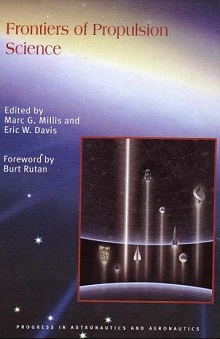Centauri Dreams
Imagining and Planning Interstellar Exploration
Go JUICE
Take a look at our missions to Jupiter in context. The image below shows the history back to 1973, with the launch of Pioneer 10, and of course, the Voyager encounters. We also have the flybys by Ulysses, Cassini and New Horizons, each designed for other destinations, for Jupiter offers that highly useful gravitational assist to help us get places fast. JUICE (Jupiter Icy Moons Explorer) joins the orbiter side of the image tomorrow, with launch aboard an Ariane 5 from Kourou (French Guiana) scheduled for 1215 UTC (0815 EDT) on Thursday. You can follow the launch live here or here.
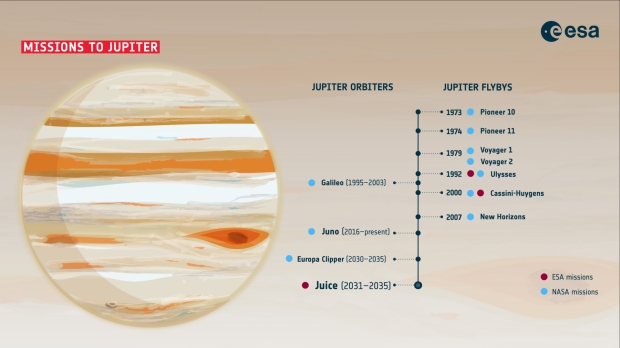
The first gravitational maneuver will be in August of next year with a Lunar-Earth flyby, followed by Venus in 2025 and then two more Earth flybys (2026 and 2029) before arrival at Jupiter in July of 2031. I’ve written a good deal about both Europa Clipper and JUICE in these pages and won’t go back to repeat the details, but we can expect 35 icy moon flybys past Europa, Ganymede and Callisto before insertion into orbit at Ganymede, making JUICE the first mission that will go into orbit around a satellite of another planet. Needless to say, we’ll track JUICE closely in these pages.
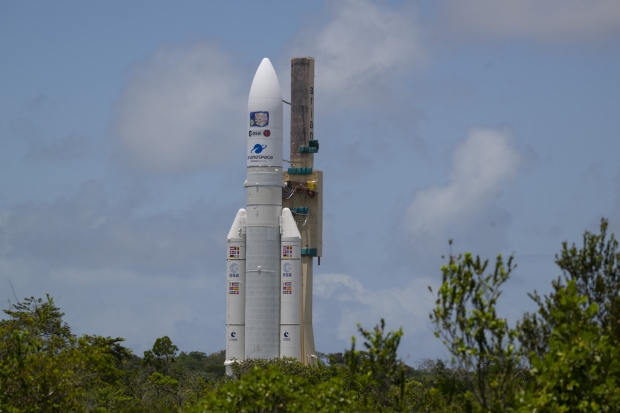
Image: Ariane 5 VA 260 with JUICE, start of rollout on Tuesday 11 April. Credit for this and the above infographic: ESA.

Uranus: Diamond Rain, Bright Rings
Thinking about the ice giants, as I have been doing recently in our look at fast mission concepts, reminds me of the ‘diamond rain’ notion that has grown out of research into experiments with the temperatures and pressures found inside worlds like Uranus and Neptune. The concept isn’t new, but I noted some months ago that scientists at the Department of Energy’s SLAC National Accelerator Laboratory had been studying diamond formation in such worlds in the presence of oxygen. Oxygen, it turns out, makes it more likely that diamonds form that may grow to extreme sizes.
So let me turn back the clock for a moment to last fall, when news emerged about this exotic precipitation indicating that it may be more common than we had thought. Using a material called PET (polyethylene terephthalate), the SLAC researchers created shock waves within the material and analyzed the result with X-ray pulses. The scientists used PET because of its balance between carbon, hydrogen and oxygen, components more closely mimicking the chemical composition of Neptune and Uranus.
While earlier experiments had used a plastic material made from hydrogen and carbon, the addition of oxygen made the formation of diamonds more likely, and apparently allowed them to grow at lower temperatures and pressures than previously thought possible. The team, led by Dominik Kraus (SLAC/University of Rostock), suggests that such diamonds under actual ice giant conditions might reach millions of carats in weight, forming a layer around the planetary core. Silvia Pandolfi, a SLAC scientist involved in this work, was quoted in a SLAC news release last September:
“We know that Earth’s core is predominantly made of iron, but many experiments are still investigating how the presence of lighter elements can change the conditions of melting and phase transitions. Our experiment demonstrates how these elements can change the conditions in which diamonds are forming on ice giants. If we want to accurately model planets, then we need to get as close as we can to the actual composition of the planetary interior.”
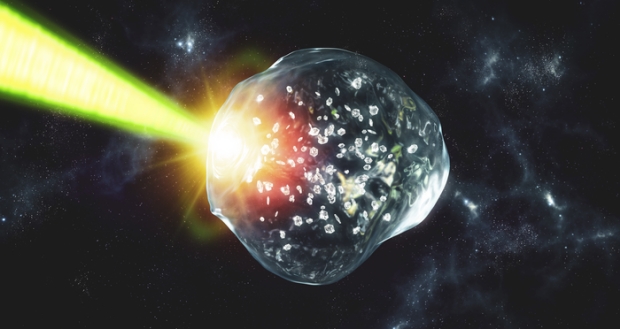
Image: Studying a material that even more closely resembles the composition of ice giants, researchers found that oxygen boosts the formation of diamond rain. The team also found evidence that, in combination with the diamonds, a recently discovered phase of water, often described as “hot, black ice” could form. Credit: Greg Stewart/SLAC National Accelerator Laboratory.
Diamond rain is a startling concept, hard to visualize, and given the possibility that ice giants may be one of the most common forms of planet, the phenomenon may be occurring throughout the galaxy. Something to ponder as we look at the new image from Uranus just in from the James Webb Space Telescope, which highlights the planet’s rings as never before, while also revealing features in its atmosphere. The rings themselves have only rarely been imaged, but have been seen through Voyager 2’s perspective and through the adaptive optics capabilities of the Keck Observatory.
The brightness of the rings is striking, the result of the telescope’s Near-Infrared Camera (NIRCam) working through filters at 1.4 and 3.0 microns, shown here in blue and orange. The Voyager 2 imagery was as featureless as Voyager 1’s image of Titan, showing a lovely blue-green orb in visible wavelengths, but the power of working in the infrared is clear with the JWST results. Note the brightening at the northern pole (Uranus famously lies on its side almost 90 degrees from the plane of its orbit). This ‘polar cap’ formation appears when it is summer at the pole and disappears in the fall.
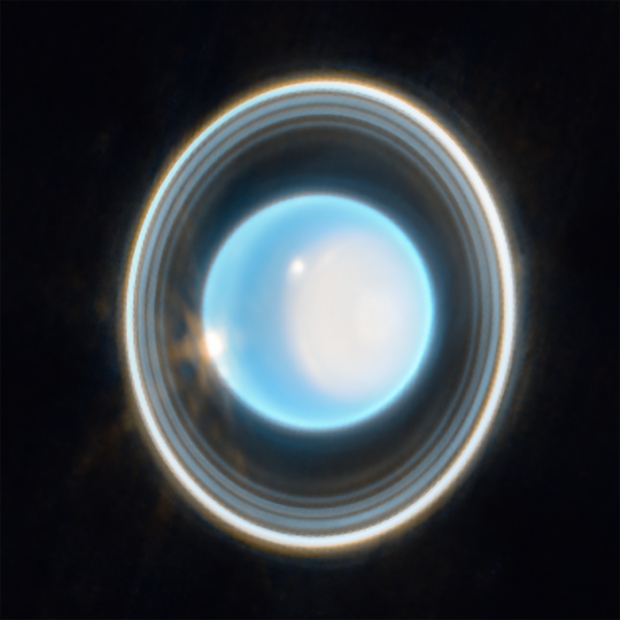
Image: This zoomed-in image of Uranus, captured by Webb’s Near-Infrared Camera (NIRCam) Feb. 6, 2023, reveals stunning views of the planet’s rings. The planet displays a blue hue in this representative-color image, made by combining data from two filters (F140M, F300M) at 1.4 and 3.0 microns, which are shown here as blue and orange, respectively. Credit: NASA, ESA, CSA, STScI. Image processing: J. DePasquale (STScI).
A few other features emerge here beyond the edge of the cap, including a second bright cloud at the left limb of the planet that seems to be related to storm activity. As to Uranus’ 13 known rings, 11 of them appear in the image. The other two, quite faint, are more visible, according to JWST scientists, during ring-plane crossings, which is a time in the planetary orbit when we see the rings edge-on. The Hubble instrument first discovered them during the last crossing, in 2007; the next will occur in 2049.
We’re dealing here with a brief exposure (12 minutes), but even so, a number of the planet’s moons can be found in the wider view shown below. Looking at this oddball system, I have to wonder whether the idea of a giant impact knocking it onto its side holds water. Can we get this result from resonance effects and the gravitational influence of the gas giants through periods of migration? The fact that the question can even be asked highlights how little we know about this particular ice giant. And whatever the cause, imagine a world where the Sun disappears for 42 years, a world of water, methane and ammonia, a rocky core and perhaps a rain of diamonds.
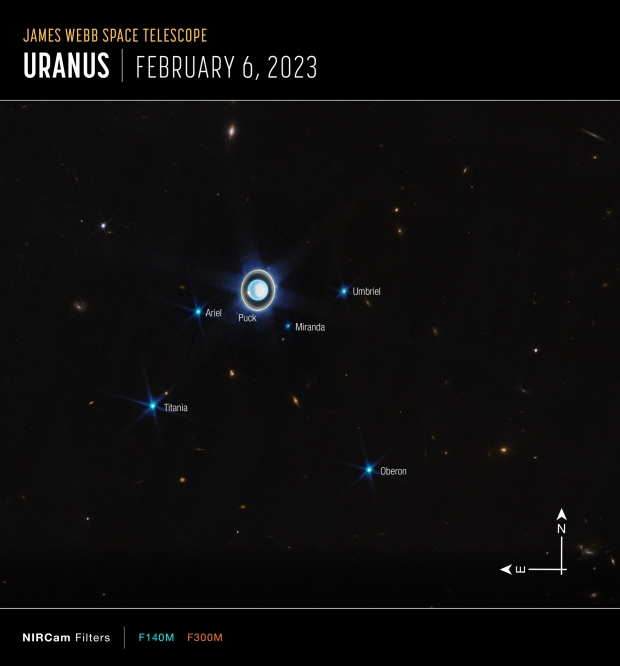
Image: This wider view of the Uranian system with Webb’s NIRCam instrument features the planet Uranus as well as six of its 27 known moons (most of which are too small and faint to be seen in this short exposure). A handful of background objects, including many galaxies, are also seen. Credit: NASA, ESA, CSA, STScI. Image processing: J. DePasquale (STScI).
As I’ve mentioned before, a mission to Uranus including an orbiter has been identified as a priority in the 2023-2033 Planetary Science and Astrobiology decadal survey. A flagship mission of Cassini-class at Uranus would be a great boon to science, but the suspicion grows that before it can fly, we’ll have learned how to reach the ice giants faster, and with mission strategies far different from those used for Cassini.
The paper on diamond rain is Zhiyu He et al., “Diamond formation kinetics in shock-compressed C?H?O samples recorded by small-angle x-ray scattering and x-ray diffraction,” Science Advances Vol. 8, Issue 35 (2 September 2022). Full text.

Self-Assembly: Reshaping Mission Design
It’s interesting to contemplate the kind of missions we could fly if we develop lightweight smallsats coupled with solar sails, deploying them in Sundiver maneuvers to boost their acceleration. Getting past Voyager 1’s 17.1 kilometers per second would itself be a headline accomplishment, demonstrating the feasibility of this kind of maneuver for boosting delta-v as the spacecraft closes to perhaps 0.2 AU of the Sun before adjusting sail attitude to get maximum acceleration from solar photons.
The economic case for smallsats and sails is apparent. Consider The Planetary Society’s LightSail-2, a solar sail in low Earth orbit, which demonstrated its ability to operate and change its orbit in space for multiple years before reentering Earth’s atmosphere in November of 2022. Launched in 2018, LightSail-2 cost $7 million. NASA’s Solar Cruiser, a much larger design still in development despite budging hiccups, weighs in at $65 million. Slava Turyshev and team at the Jet Propulsion Laboratory independently verified a cost model, with the help of Aerospace Corporation, of $11 million for a one-year interplanetary flight based on their Technology Demonstrator design.
Those numbers go up with the complexity of the mission, but can be reduced if we take advantage of the fact that spacecraft like these can be repurposed. A string of smallsat sailcraft sent, for example, to Uranus to conduct flybys of the planet, its moons and rings, would benefit from economies of scale, with successive missions to other outer system targets costing less than the ones that preceded them. Here the contrast between dedicated flagship missions (think Cassini or the Decadal Suevey’s projected Uranus Orbiter) could not be greater. Instead of a separately developed spacecraft for each destination, the modular smallsat/sail model creates a base platform allowing fast, low-cost missions throughout the Solar System.
To the objection that we need orbiters at places like Uranus to get the best science, the answer can only be that we need both kinds of mission if we are not to bog down in high-stakes financial commitments that preclude targets for decades at a time. Of course we need orbiters. But in between, the list of targets for fast flybys is long, and let’s not forget the extraordinary range of data returned by New Horizons at Pluto/Charon and beyond. As the authors of the recent paper from the JPL team note, heliophysics can benefit from missions sent to various directions in the heliosphere:
The shape of the heliosphere and the extent of its tail are subject to debate and the new model of the heliosphere—roughly spherical with a radius of ?100 AU—needs confirmation. Of course, every mission out to >100 AU will test it, but a series of paired missions (nose and tail, and in perpendicular directions) would provide a substantial improvement in our understanding of ISM/solar wind interactions and dynamics. High-velocity, low-cost sailcraft could probe these questions related to the transition region from local to pristine ISM sooner and at lower cost than competing mission concepts. Since the exact trajectory is not that crucial, this would also provide excellent opportunities for ad hoc trans-Neptunian object flybys.

Image: This is Figure 5 from the paper. Caption: New paradigm – fast, low-cost, interplanetary sailcraft with trajectories unconstrained to the ecliptic plane. Note the capability development phases from TDM (at 5–6 AU/yr) to the mission to the focal region of the SGL (20–30 AU/yr). Credit: Turyshev et al.
What I see emerging, however, is a new model not just for flyby missions but for the kind of complicated mission we’ve gotten so much out of through spacecraft like Cassini. We are on the cusp of the era of robotic self-assembly, which means we can usefully combine these ideas. Ten fast smallsats capable of flying considerably faster than anything we’ve flown before can, in this vision, self-assemble into one or more larger craft enroute to a particular destination. The Solar Gravitational Lens mission as designed at JPL relies on self-assembly to achieve the needed payload mass and also draws on the ability of smallsats with sails to achieve the needed acceleration.
We can trace robotic self-assembly all the way back to John von Neumann’s self-replicating probes, but as far as I know, it was Robert Freitas who in 1980 first took the idea apart in terms of a serious engineering study. Freitas applied self-assembly to a highly modified probe based on the Project Daedalus craft. Freeman Dyson considered robotic methods using robot swarms to build large structures and also proposed his famous ‘Astrochicken,’ a 1 kg self-replicating automaton that was part biological and was conceived as a way of exploring the Solar System. Eric Drexler is well known for positing nanomachines that could build large structures in space.
So the idea has an interesting past, and now we can consider the Turyshev paper we’ve been looking at in these past few posts as the outline of an overall rethinking of the classic one-destination-per-mission concept, one that allows cheap flybys but also alternate ways of putting larger instrumented craft into the kind of orbits the 2022 Decadal has recommended for its putative Uranus mission. Modular smallsat design might incorporate self-assembly including propulsion modules for slowing the encounter speed of a mission to the outer planets. Here is what the paper says on the topic as it relates to a possible mission to search for life in the plumes of Enceladus:
Another mission type may rely on in-flight aggregation [8], which may be needed to allow for orbital capture. For that, after perihelion passage and while moving at 5 AU/yr (?25 km/s), the microsats would perform inflight aggregation to make a fully capable smallsat to satisfy conditions for in situ investigations. One such important capability may be enhanced on-board propulsion capable of providing the ?v needed to slow down the smallsat. In this case, before approaching Enceladus, the spacecraft reduces its velocity by 7.5 km/s using a combination of on-board propulsion and gravity assists. Moving in the same direction with Enceladus (which orbits Saturn at 12.6 km/s) it achieves the conditions for in situ biomaterial collection.
We might, then, consider the option of either multiple flybys of small probes or larger payloads in self-assembling smallsat craft of the ice giants and other targets in the outer reaches of the system. The paper names quite a few possibilities. Among them:
The so-called ‘interstellar ribbon,’ evidently determined by interactions between the heliosphere and the local interstellar magnetic field.
Indirect probing of sailcraft trajectory in search of information about the putative Planet 9 and its gravitational effects somewhere between 300 and 500 AU of the Sun (Breakthrough Starshot has also discussed this). And if Planet 9 is found, target missions to a world much too far away to study with chemical propulsion methods.
The Kuiper Belt and beyond: KBOs and dwarf planets like Haumea, Makemake, Eris, and Quaoar within roughly 100 AU of the Sun, or even Sedna, whose orbit takes it well beyond 100 AU.
Observations of Earth as exoplanet, observing its transits across the Sun and improving transit spectroscopy.
Missions to interstellar objects like 1/I ‘Oumuamua, which are believed to occur in substantial numbers and likely to be a rich field for future discovery.
Studies of the local interplanetary dust cloud responsible for the zodiacal light.
Exoplanet imaging through self-assembling smallsats, the JPL Solar Gravitational Lens mission.
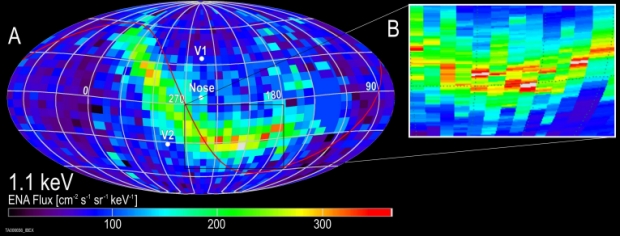
Image: This is Figure 9 from the paper. Caption: IBEX ENA Ribbon. A closer look suggests that the numbers of ENAs are enhanced at the interstellar boundary. A Sundiver spacecraft will go through this boundary as it travels to the ISM. Credit: SwRI.
As examined in JPL’s Phase III study for the SGL mission (the term ‘microsat’ below refers to that category of smallsats massing less than 20 kilograms):
The in-flight (as opposed to Earth-orbiting or cislunar) autonomous assembly [8] allows us to build large spacecraft from modules, separately delivered in the form of microsats (<20 kg), where each microsat is placed on a fast solar system transit trajectory via solar sail propulsion to velocities of ?10 AU/yr. Such a modular approach of combining various microsats into one larger spacecraft for a deep space mission is innovative and will be matured as part of the TDM flights. This unexplored concept overcomes the size and mass limits of typical solar sail missions. Autonomous docking and in-flight assembly are done after a large ?v maneuver, i.e., after passing through perihelion. The concept also offers the compelling ability to assemble different types of instruments and components in a modular fashion, to accomplish many different mission types.
To say that robotic assembly is an ‘unexplored concept’ underlines how much would have to be resolved to make such a daring mission work. The paper goes into more details, of which I’ll mention the high accuracy demanded in terms of trajectory. Remember, we’re talking about flinging each microsat into the outer system after perihelion on its own, with the need for successful rendezvous and assembly not in Earth orbit but in outbound cruise. Docking technologies for structural, power and data connections would go far beyond those deployed on any missions flown to date.
Even so, I’m persuaded this concept is feasible. It’s also completely brilliant.
Autonomous in-space docking has been demonstrated, while proximity operation technologies specific to such missions can be developed with time. I’ve referred before in these pages to NASA’s On-Orbit Autonomous Assembly from Nanosatellites (OAAN) project, and note that the agency has followed with a CubeSat Proximity Operations Demonstration (CPOD) mission. Needless to say, we’ll keep an eye on these and other efforts. I’m reminded of the intricacies of JWST deployment and have to say that from this layman’s view, we are building the roadmap to make self-assembly happen.
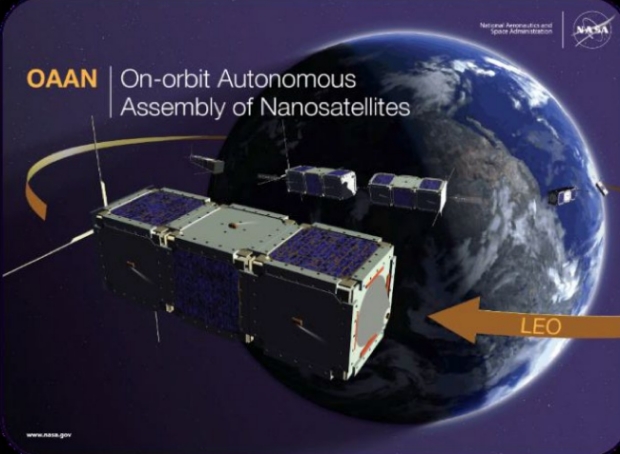
Image: An early artist’s impression of OAAN. Credit: NASA.
Alex Tolley has been looking at self-assembly issues in the comments to the previous post. I highly recommend reading what he has to say. I noted this about redundancy, an issue I hadn’t considered. Quoting Alex:
“Normally, a swarm of independent probe sails would offer redundancy in case of failure. A swarm of flyby sail probes can afford the odd failure. However, this is not the case with probes that must be combined into a functioning whole. Now we have a weakest link problem. Any failure could jeopardize the mission if a failed probe has a crucial component needed for the final combined probes. That failure could be with the payload, or with the sail system itself. A sail may fail with a malfunctioning blade, which prevents being able to rendezvous with the rest of the swarm, or more subtly, be unable to manage fine maneuvering for docking.”
Self-assembly is complex indeed, making early missions that can demonstrate docking and assembly a priority. Success could re-shape how we conceive deep space missions.
For a more detailed look at how the JPL team views self-assembly in the context of the SGL mission, see Helvajian et al., “A mission architecture to reach and operate at the focal region of the solar gravitational lens” (abstract). The Turyshev et al. paper is “Science opportunities with solar sailing smallsats,” available as a preprint. I’ve also written about self-assembly in Solar Gravitational Lens: Sailcraft and In-Flight Assembly.

Building Smallsat Capabilities for the Outer System
‘LightCraft’ is the term used by Slava Turyshev’s team at JPL and elsewhere to identify the current design of the ambitious mission we looked at briefly in the previous post. This is a Technology Demonstrator Mission (TDM), which can be considered a precursor to what may become a mission to the solar gravitational lens. The mission concept is under active investigation, partly via a Phase III grant from NASA’s Innovative Advanced Concepts office. Reaching the focal region (for practical purposes, beyond 600 AU) in less than 25 years requires changes to our thinking in propulsion, not to mention payload size and the potential of robotic self-assembly en-route.
Hence the paper the researchers have just released, “Science opportunities with solar sailing smallsats,” which makes the case for leveraging our growing expertise in solar sail design and the highly successful move toward miniaturization in space systems, which the authors believe can be extended to include smallsats operating in the outer Solar System.
The TDM mission is conceived as a series of preparatory flights that allow the testing and validation of the technology and operational concepts involved in a mission to the focal region. The implications are hardly limited to the outer Solar System, for the smallsat/sail paradigm should be applicable to a wide range of missions in the inner system as well.
Let’s pause for a moment on the term ‘smallsat,’ which generally refers to a spacecraft that is both small and lightweight, usually less than 500 kilograms, and sometimes much less, as when we get into the realm of CubeSats. Frequently in the news as we explore their capabilities, CubeSats can get down to less than 2 kilograms. What the authors have in mind is a demonstrator design that is scalable, the initial payload in the 1-2 kilogram range, but capable of moving up to between 36 and 50 kilograms.
The goal is a demonstrator mission that will perform a one to two-year test flight using a solar sail and a sundiver maneuver to achieve speeds greater than 5 AU per year. The figure works out to something on the order of 23.6 kilometers per second, an impressive feat given that Voyager 1, our current record holder, is moving at 17.1 kps. With the TDM demonstrating the capabilities of the sail’s vane structure and the needed control for perihelion passage, the full solar gravitational lens mission contemplates still higher velocities, reaching 20 AU per year (roughly 95 kilometers per second).
The SGL mission concept is being built around in-flight cruise assembly of the full spacecraft through modules separately delivered as 20 kilogram or less smallsats. Given that overall design, you can see the need for the demonstrator mission to shake out both sail and sundiver concepts. Thus, while the TDM payload includes science instruments, the real focus here is on demonstrating the method: Use smallsat technologies with a highly maneuverable sailcraft to enable the fast travel times that will make reaching the focal region feasible. This is not the place to get into exoplanet imaging; we’ve discussed what a full-scale SGL mission could accomplish in these pages before. See, for example, A Mission Architecture for the Solar Gravity Lens.
So let’s focus on the sail and the sundiver maneuver. In the last post I mentioned the unusual design of the sail, which grows out of work at JPL in conjunction with L’Garde, further refined by space services company Xplore. The sail design, pictured below, draws on square panels aligned along a truss to provide the cumulative sail area needed for the mission. It’s a striking object, not the conventional image of a solar sail – I did a double take when I first encountered it in 2020. L’Garde has put together an eye-catching 1:3 scale model that hangs at the Xplore facility in Washington state.
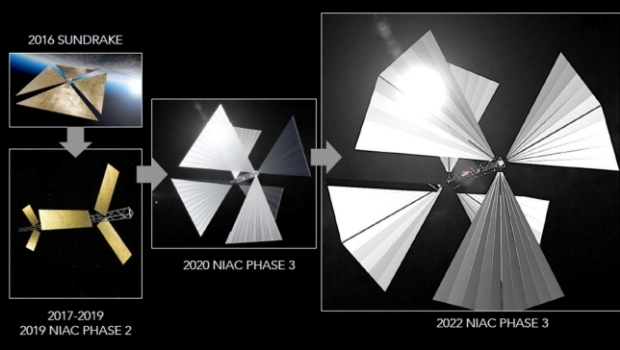
Image: This is Figure 3 from the paper. Caption: TDM vehicle configurations (PDR: July 18, 2022). Credit: Turyshev at al.
The LightCraft TDM is envisioned as a 3-axis controlled spacecraft capable of the attitude control crucial for the Sundiver maneuver it will perform to reach cruise speed. Here are a few relevant details from the paper. Note the remark at paragraph close:
Each sail element, or vane, can also be articulated to provide fine control to both the resultant thrust from solar radiation pressure and the vehicle’s attitude. Each dynamic vane element is also a multifunctional structure hosting photovoltaics and communication elements with the requisite degrees of freedom to meet competing operational and mission requirements. The current TDM design total vane area is 120 m2 and the mass of the integrated TDM vehicle is 5.45 kg, resulting in an area-to-mass ratio of A/m = 22 m2/kg, or nearly 3 times the performance of other existing and planned sailcraft.
The mission concept relies on placing the sailcraft in a trajectory that takes it to solar perihelion – head first for the Sun, then leave it at high velocity, using the momentum of solar photons to push the craft, and again using the precise attitude control available through the SunVane design to adjust subsequent trajectory as needed. What this trajectory demands, then, is sail materials that can withstand a perihelion in the range of 15 to 20 solar radii, which the Phase III study research indicates will be available within the present decade.
This proof-of-concept demonstrator mission would aim at deployment through a rideshare launch, sharply reducing the cost in comparison with larger payloads, with checkout in a ‘super-synchronous’ orbit (meaning higher than geostationary orbit and moving faster than Earth’s rotation). The paper describes an ‘outspiral’ into interplanetary space following the checkout phase, with a pivot at perihelion (listed here as 0.24 AU) to harvest the solar momentum needed to reach cruise velocity. The SunVane design allows the necessary maneuvering, as follows:
The trajectory is achieved with three simple control laws to maneuver the vehicle from geosynchronous orbit to perihelion and then egress: 1) maximum acceleration: align vanes perpendicular to the Sun to increase velocity; 2) no acceleration: align vanes edge-on to the Sun; and 3) maximum deceleration: align vanes so that the resultant force is opposite to the heliocentric velocity vector, to decrease orbital kinetic energy.
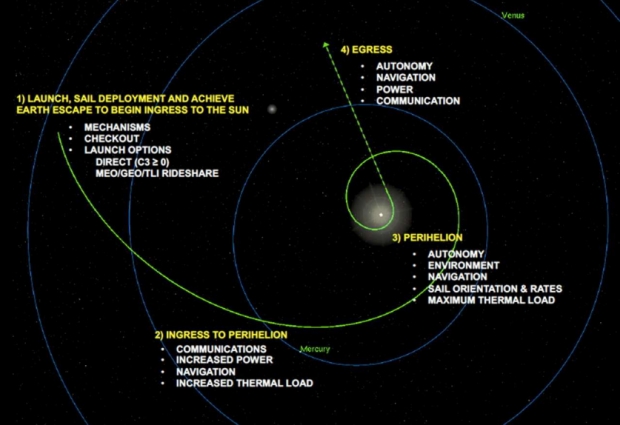
Image: This is Figure 2 from the paper. Caption: Common TDM mission phases and systems engineering objectives. Trajectory plot shown is for the SGL mission. Credit: Turyshev et al.
You would think the diciest part of the mission would be at perihelion (and of course it’s crucial), but I was interested to see that the authors consider the most dynamic phase for the sailcraft is during the exit from Earth, where the vehicle alternates between acceleration and no-acceleration (factoring in eclipse periods). Reaching interplanetary space, the sail decelerates inward toward the Sun. The sail vanes are re-oriented at perihelion, with six degrees of freedom to ensure responsiveness to error.
All of this, the authors report, is well within the capabilities of the kind of onboard inertial sensors we already use in space operations. With the vanes used for propulsion, attitude determination and control are handled by reaction wheels, gyro, star tracker, sun sensors and accelerometers for yaw, pitch and roll. The preliminary studies reported in this paper show a sail area on the order of 100–144 m2, with the overall spacecraft mass coming in between 4.2 and 6.4 kg. Note that the demonstrator would use photovoltaic elements on the sail vanes for power. Future missions to the outer system will also demand radioisotope power.
I’ll turn you to the paper for further details about how the smallsat/sail concept can scale the TDM into future missions, such as sail material (currently Kapton but with other choices emerging), insulation for perihelion, and the various investigations re communications, batteries and the development of small radioisotope power sources.
So how likely is a Technology Demonstrator Mission to fly? The next steps are cited in the paper:
The 2020 NIAC Phase III study concluded with a TDM Preliminary Design Review (PDR) on July 18, 2022 [7]. Next is pre-project mission development, which includes final design, hardware development, full-scale prototype construction, as well as hardware and software testing… Should funding be available, the TDM Critical Design Review (CDR) may be conducted in November 2023, when flight project commitment is expected, including a firm costing of the TDM. The total project cost will depend on the selected mission objectives, science payload, and experiments, and is expected to be in the range of $17–20M.
It’s compelling to learn that a lightweight sundiver mission may be built at a cost of tens of millions (the authors cite $30-75 million), which is quite a contrast to the $2 to $5 billion cost of the typical flagship mission to deep space. Developing such technologies pushes us forward on the miniaturization of scientific sensors that will benefit all classes of future missions to deep space. But numerous opportunities would also open up for targets closer to home in the Solar System. We’ll look at some of those next time.
The paper is Turyshev et al., “Science opportunities with solar sailing smallsats,” available as a preprint.

The Emerging Sail/Cubesat Paradigm for Deep Space
We need to get to the ice giants. We have limited enough experience with our system’s larger gas giants, although orbital operations at both Jupiter and Saturn have been highly successful. But about the ice giants, their formation, their interiors, their moons (and even the possibility of internal oceans on these objects), we draw on only a single mission, Voyager II. Which is why the April 2022 decadal study (“Origins, Worlds, and Life: A Decadal Strategy for Planetary Science and Astrobiology 2023-2032”) recommended a Uranus mission, complete with orbiter, to be launched in the late 2030s.
Can we do this under our existing paradigm for space exploration? A new paper titled “Science opportunities with solar sailing smallsats,” written by the Jet Propulsion Laboratory’s Slava Turyshev and co-authored by major proponents of solar sail technologies, makes the case for coupling our abundant advances in miniaturization with our growing experience in solar sails to achieve missions at significantly lower cost and substantial savings in time. Because staying within the traditional game plan, we are constrained by slow chemical propulsion (or low-readiness nuclear methods) as well as decades of mission planning, not to mention cruise times in the range of 15 years to reach Uranus. These are numbers that can and should be improved, and greatly so.
Fortunately, solar sailing is moving beyond the range of experiment toward practical missions that will build on each other to advance a new paradigm – smaller and faster. Much smaller and much faster. Consider: The Japanese IKAROS sail has already demonstrated the interplanetary possibilities of sails, while the success of The Planetary Society’s LightSail-2 helped to energize the NEA-Scout mission NASA launched in 2022. Concept studies continue. Japan developed OKEANOS, a hybrid sail/ion engine design as an outer planet mission as a follow-on to IKAROS (the mission was a finalist for funding but lost out to a space telescope called LiteBIRD).
But sail technology must be wed with practical payloads, and spacecraft acceleration is proportional to the sail area divided by the spacecraft mass, which means that miniaturization and the use of smallsats win on efficiency. Here we’re reminded of the recent success of the Mars Cube One (MarCO) smallsats, which worked in conjunction with the InSight Lander and demonstrated the practicality of the highly modular and integrated CubeSat format for missions well beyond Earth orbit (see MarCO: Taking CubeSat Technologies Interplanetary). Let’s remember too the advantage of smallsat launches as ‘rideshare’ payloads, significantly reducing the outlay needed.
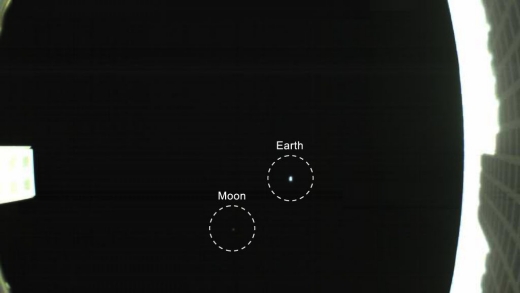
Image: The first image captured by one of NASA’s Mars Cube One (MarCO) CubeSats. The image, which shows both the CubeSat’s unfolded high-gain antenna at right and the Earth and its moon in the center, was acquired by MarCO-B on May 9, 2018. Credit: NASA/JPL-Caltech.
Solar sails are fast and, using the momentum of solar photons, require no onboard propellant, as both chemical and electrical methods do. Wedding sail propulsion to miniaturization in smallsats opens the way for spacecraft sent on ‘sundiver’ trajectories to harvest momentum from solar photons for the push to the outer Solar System. Here we’re taking advantage of a sail’s ability to change orbit by adjusting its attitude, another obvious plus. The authors believe that sailcraft built along these lines can achieve speeds of 33 kilometers per second, which works out to roughly 7 AU per year.
All of this leads to particular types of mission. From the paper:
As the solar sailing smallsats will be placed on very fast trajectories, placing Sundivers in orbit around a solar system body will be challenging. However they naturally yield several mission types including fast flybys, impactors, formation flights, and swarms. As the weight of the system is constrained, any instruments on board need to be small, lightweight, and low-power. Given the ongoing efforts in miniaturization of many instruments and subsystems, these challenges will be met by our industry partners who are already engaged in related technology developments.
As we continue to refine sail materials and advance deployment strategies, we are also learning how to harden smallsat computers for deep space while modularizing their components. Jupiter will be reachable with cruise times of two years, Saturn with three. What looms now is further development in the form of a technology demonstration mission (TDM) that has grown out of Turyshev and team’s Phase III study for NASA’s Innovative Advanced Concepts Office based on a sailcraft design that may one day reach the Sun’s gravity lens, which for effective science begins at 550 AU and extends outward.
The TDM would further develop solar sail technologies with an eye toward the kind of ‘sundiver’ maneuver that would make such fast missions possible. It will be enabled by a series of preparatory solar sail flights that will validate the final TDM vehicle.
Coming back briefly to an ice giant mission, designing and building the kind of craft envisioned in the 2022 Decadal is at least a decade’s work, and the cost of sending an orbiter to Uranus likely pushes beyond $4 billion. We’re contemplating this at the same time that the Decadal Survey is recommending, as its second highest priority for the upcoming decade, an Enceladus orbiter/lander flagship mission. NASA’s budget would be strained to the maximum to get even the Uranus mission off in the 2030s, which would push our next encounter with the ice giants back yet another decade.
The authors argue that we need to get realistic about what we can do with fast flybys not just to the ice giants but to numerous destinations in the Solar System. In the next several posts, I want to explore the TDM mission as presented in the new paper, considering the mission concept and implications before moving on to look at the kind of destinations the combination of sails and smallsats will enable us to reach.

Image: This is from the paper’s Figure 1, showing sailcraft design evolution during the period of 2016-2022. We’ll talk about this unusual configuration in the next post.
The paper is Turyshev et al., “Science opportunities with solar sailing smallsats,” available as a preprint.

‘Oumuamua: Avi Loeb’s Response to the Molecular Hydrogen Theory
The enigmatic ‘Oumuamua continues to stir controversy. Last week we looked at a new paper from Jennifer Bergner (UC-Berkeley) and Darryl Seligman (Cornell University), discussing a mechanism for the interstellar object’s unusual non-gravitational acceleration. The researchers explored the possibility that ice impacted by high-energy particles like cosmic rays would dissociate water in a comet to create molecular hydrogen within the ice. Was the warming of this hydrogen, all but undetectable according to the authors, the cause of outgassing and the anomalous acceleration?
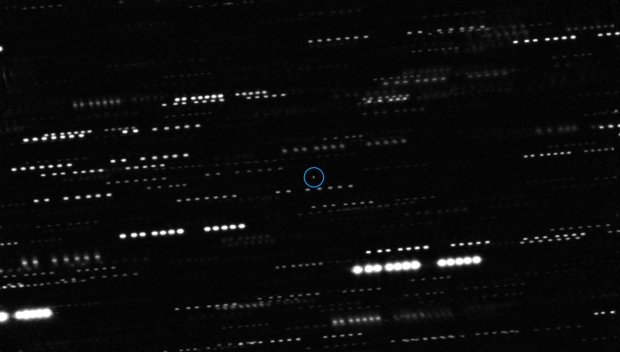
Image: This very deep combined image shows the interstellar object ‘Oumuamua at the center of the image. It is surrounded by the trails of faint stars that are smeared as the telescopes tracked the moving comet. Credit: ESO/K. Meech et al.
Answering the question in a paper just submitted to the arXiv site is Harvard’s Avi Loeb, working with Thiem Hoang (Korea University of Science and Technology), who home in on Bergner and Seligman’s finding that the surface temperature of ‘Oumuamua can exceed 140 K at perihelion, enough to produce this evaporation. Loeb and Hoang argue that this calculation ignores the effect of evaporative cooling of the molecular hydrogen. The authors proceed to take such cooling into account and find that the surface temperature of H2 water ice is lower than that calculated by Bergner and Seligman by a factor of 9. This is turn reduces the projected outgassing.
From the paper:
…we found that the evaporative cooling is much more efficient than radiative cooling at temperatures above 20 K (see Figure 1, left panel). By taking into account the evaporative cooling by H2 evaporation, our results (see Figure 1, right panel) show that the surface temperatures of H2-water ice are lower by a factor of 9 than the temperature obtained by Bergner & Seligman (2023) (see their figure 3). Therefore, the thermal speed of outgassing H2 is decreased by a factor of 3.
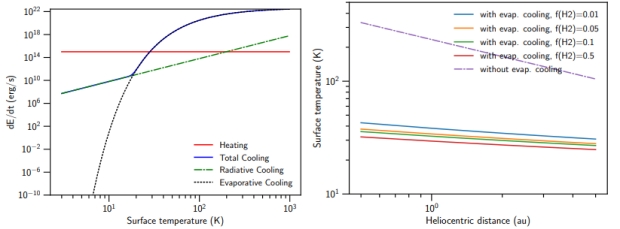
Image: This is Figure 1 from the paper. Caption: Left panel: comparison of heating and cooling rates when the object is located at 1.4 times the Earth separation from the sun. Evaporative cooling by H2 is dominant over radiative cooling. The intersection of heating and total cooling determines the equilibrium surface temperature. Right panel: surface temperature at different distances, calculated for the case with (solid lines) and without (dashed-dotted line) evaporative cooling. Different ratio of H2 to water is assumed. Evaporative cooling by H2 decreases significantly the surface temperature compared to the case without evaporative cooling (dashed-dotted line).
And this is a problem for the molecular hydrogen evaporation scenario. The result of this decrease in outgassing is that ‘Oumuamua would have had to have been what the authors call an ‘oxygen iceberg’ to produce enough molecular hydrogen to drive the observed acceleration, a highly unlikely scenario for the following reason:
Given this constraint, the requirement for a surface layer that is made of pure molecular hydrogen will not survive the journey through interstellar space as a result of heating by starlight (Hoang & Loeb 2020). Moreover, the lower surface temperature also influences the thermal annealing of water ice, a key process that is appealed to by Bergner & Seligman (2023) to release H2.
The paper is Hoang & Loeb, “Implications of evaporative cooling by H2 for 1I/‘Oumuamua” (full text).


